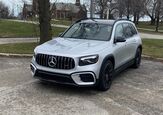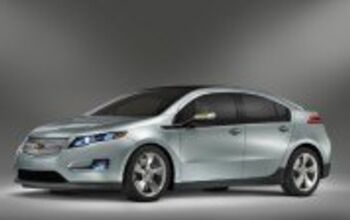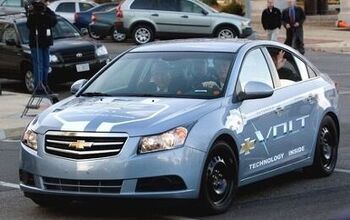Volt Birth Watch 139: Niche
Recent reports that GM won’t even let the fanboys drive their Volt mules in the all-important range-extending “generator mode” were troubling enough, but recent chatter from inside GM suggests that maybe Chevy should have simply designed the Volt as an electric-only vehicle. “It’s best utilized in urban vehicles,” GM Product chief Tom Stephens explains to Automotive News [sub]. “We have to consider what is the usage of the person buying the vehicle. For a commuter who drives 40 miles a day and takes it shopping on weekend, it’s the perfect application.” Yes, and a Hummer is the perfect vehicle for those who want to practice counterinsurgency tactics on the weekends, but the market doesn’t necessarily reflect that, does it? No, it’s image über alles at GM. Is it any surprise then to learn (via GM-volt.com) that the Volt was originally imagined by Bob Lutz as an EV-only city car?
Despite starting with an all-electric city car (an “urban vehicle for a commuter who drives 40 miles a day and takes it shopping on weekends,” so to speak) and ditching those plans for the range-extended Volt, we now hear that GM is developing the car Lutz wanted to build before John Lauckner interfered. Only it’s going to debut after the Volt launches.
“The microcar would offer 90 miles of range using the same 16 kWh battery pack as the Volt,” says gm-volt of the Opel/Vauxhall Trixx. “Presumably the car’s extremely small size and lack of generator and associated hardware would allow for the increase in range.” The “original Volt” microcar is now planned as a 2012 Europe-only model. But why?
From Subaru to BMW, the first electric cars are emerging as small, city-centric vehicles. With range limited by battery technology, smart manufacturers understand that electric cars will be niche city vehicles for a number of years. And with only pathetic neighborhood electric vehicles (NEVs) currently on offer in the US market, short-term strategies should be focused on winning sales from those who might consider an NEV if it weren’t limited to 25 mph. But that’s not the Chevy way.
Relentless hype has created the impression that the Volt will be a “real car,” an impression that it will always struggle to live up to. As strange as it may seem to read this in the pages of TTAC, Bob Lutz’s comfort level with niche vehicles actually showed a more realistic path forward. Had GM developed a purpose-built city car with less room and no range extender as its first EV, it could have offered more electric range and more realistic expectations about the technology (not to mention a more realistic price point).
Instead it’s going with the Volt, an (allegedly) extended-range EV that pretends to be a mainstream American car. Is GM putting the cart before the horse? More like putting the range-extender before the proven EV. As witnessed by the fact that even GM marketers don’t understand that it doesn’t actually charge the batteries.
More by Edward Niedermeyer
Latest Car Reviews
Read moreLatest Product Reviews
Read moreRecent Comments
- Akila Hello Everyone, I found your blog very informative. If you want to know more about [url=
- Michael Gallagher I agree to a certain extent but I go back to the car SUV transition. People began to buy SUVs because they were supposedly safer because of their larger size when pitted against a regular car. As more SUVs crowded the road that safety advantage began to dwindle as it became more likely to hit an equally sized SUV. Now there is no safety advantage at all.
- Probert The new EV9 is even bigger - a true monument of a personal transportation device. Not my thing, but credit where credit is due - impressive. The interior is bigger than my house and much nicer with 2 rows of lounge seats and 3rd for the plebes. 0-60 in 4.5 seconds, around 300miles of range, and an e-mpg of 80 (90 for the 2wd). What a world.
- Ajla "Like showroom" is a lame description but he seems negotiable on the price and at least from what the two pictures show I've dealt with worse. But, I'm not interested in something with the Devil's configuration.
- Tassos Jong-iL I really like the C-Class, it reminds me of some trips to Russia to visit Dear Friend VladdyPoo.


































Comments
Join the conversation
what sucks for Lutz, in 2007 he bought 53,336 shares of GM stock at a price of $20.09 a share. He still owns 81,360 shares of GM stock. ouch! He should have dumped it like Kerkorian...
law stud - The battery is only recharged to 85% SOC in an overnight charge, so possibly they might let regen push it higher. They might not, figuring the hit on battery life (ie number of cycles for a given degradation in capacity) isn't worth the extra range. Those with calculators will rapidly work out that if you have a nominal 16 kWh battery pack that is only ever charged to 85% full, and discharged to 30%, you are getting a lot less actual battery capacity than it says on the box. About 9 kWh.